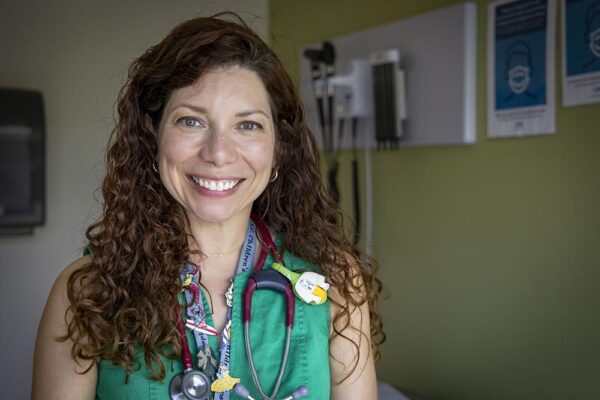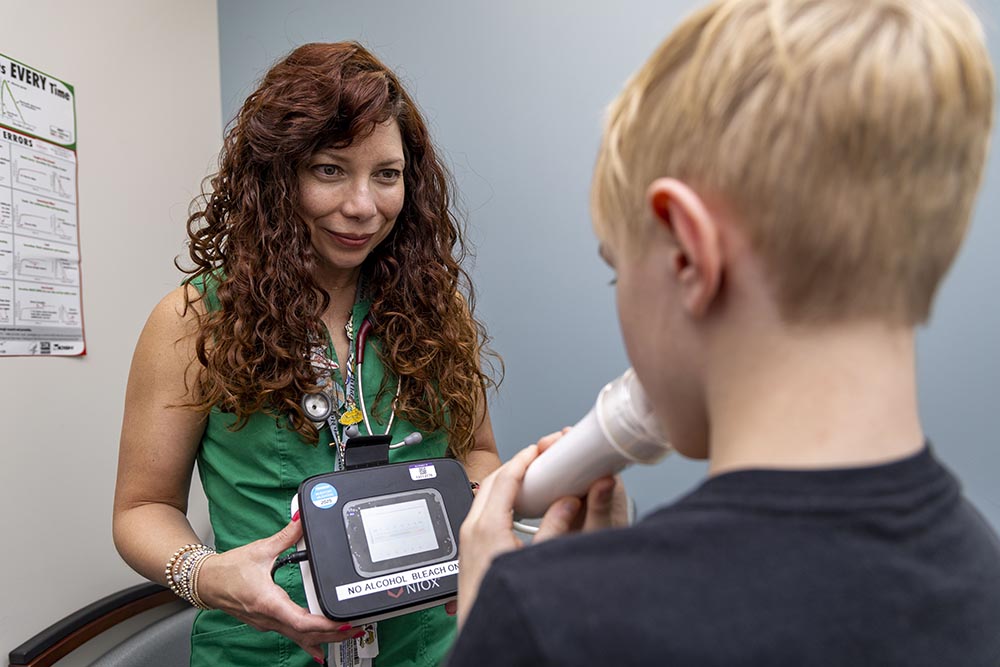Hernandez is a pediatric allergist and immunologist at the UNC School of Medicine and director of the N.C. Child Health Research Network. She is working to make access to asthma care and research studies easier for everyone, especially those living in rural areas.
She believes advanced treatments, such as injectable medications, play a crucial role in significantly improving the quality of life for patients with difficult-to-treat asthma. In her lab, she is testing therapeutic interventions aimed at reducing inflammation caused by environmental allergens and air pollution.
“There are gaps in the different types of asthma that people experience for which we don’t have effective medications,” she notes. “I want to provide access to clinical trials so we can explore more options for these individuals.”
Impact Report
![]()
UNC Children’s lung disease program is consistently recognized as one of the country’s best by U.S. News & World Report on its “America’s Best Children’s Hospitals” list.

Asthma is a chronic respiratory condition that impacts nearly 25 million Americans, including about 5 million children, according to the CDC. The N.C. Department of Health and Human Services reports that about 8% of adults and 10% of children in North Carolina are affected by this condition.
Identifying triggers
Asthma is a chronic lung disease that can lead to episodes of wheezing, chest tightness, breathlessness, and coughing. Asthma attacks are the leading cause of missed school or work for children and young adults, according to the Centers for Disease Control and Prevention (CDC).
Research in this area can significantly improve the lives of those affected by asthma. It helps us understand the causes, development, and effective treatments for the disease, potentially leading to better prevention and management strategies.
“We have made medicine and research very difficult for people to understand or relate to,” Hernandez says. “I think this has limited the quality of the science we’ve conducted and how we share and implement that science in communities.”
Hernandez’s research explores therapeutic strategies to combat inflammation caused by environmental exposures. This inflammation can be triggered by pollutants like particulate matter, ozone, carbon monoxide, nitrogen dioxide, and sulfur dioxide. It can also stem from allergens like tree pollen, dust mites, molds, and animal dander.
For Hernandez, this issue is personal; her father developed asthma after being exposed to lead-based paint without protection while painting buses during his military service in the Korean War.
In her lab, she is studying a protein known as Interleukin-1 (IL-1), which helps the immune system fight off infections and injuries. But, in the context of asthma, IL-1 can worsen inflammation by sending signals that cause the airways to become swollen and narrowed, making it difficult to breathe. Currently, Hernandez is conducting a study that investigates repurposing medications that block IL-1 to treat asthma.
Hernandez is committed to finding better and more accessible treatments, but her vision for this work wasn’t always so clear.
Turning pain into purpose
During Hernandez’s sophomore year of college, her mom was diagnosed with cancer. Her Puerto Rican parents had lived in the U.S. decades and spoke English, but they struggled to navigate the health care system and understand medical terminology.
“Many doctors spoke over them, and it felt cold and lonely,” Hernandez recalls.
Fortunately, there was a Spanish-speaking hematology-oncology fellow who took care of her mother.
“He was just wonderful,” Hernandez remembers. “And he wasn’t just conveying the information in a way that they understood it; he also genuinely cared about them.”
The experience made her want to become a doctor too.

Michelle Hernandez (photo by Megan Mendenhall)
She attended medical school with the initial plan of becoming an adult cancer specialist to help families like hers. But she found her rotation in adult oncology challenging to cope with. Although she was good at it, she wasn’t sure if she wanted to pursue it long-term.
Toward the end of her third year of medical school, she signed up for a pediatrics rotation. At first, she worried about dealing with the stress and demands parents can sometimes bring into the clinic.
But after a few weeks, she found herself enjoying it.
“I was smiling and having fun,” she says. “And based on my experience with my parents when my mom got sick, I could relate to where these parents were coming from in terms of being scared and not understanding what was happening to their child.”
After repeating another rotation in pediatric intensive care, she realized it was her calling.
“This is what I was meant to do,” she says. “It’s the best decision I ever made, and I wouldn’t trade it for anything.”
Bridging research and care
After completing her pediatrics residency at UNC Hospitals, Hernandez received an allergy and immunology fellowship at the University of California San Diego, where she focused on the innate immune system, the body’s first defense against pathogens. While she enjoyed her time there studying ear infections, she felt unfulfilled working solely with animal models and sought a way to continue her research with human patients.
Soon, Hernandez was recruited back to Carolina, where she had the opportunity to work directly with patients and apply the knowledge she gained during her residency to understand how air pollution affects the lungs, particularly in individuals with asthma.
Much of her initial research examined how ozone and endotoxins — molecules released by bacteria when they die — contribute to inflammation in people with asthma. Simultaneously, Hernandez was treating pediatric patients with severe asthma in the clinic.
Looking for a way to integrate both areas of her work, she realized that she had a large cohort of patients with poorly controlled asthma. Given her interest in how air pollution impacts this condition, she thought: Why not start research with the patient populations I already have?
“This was my first foray into community-based participatory research,” Hernandez shares. “I began talking to my patients. I asked them questions about study design and what would motivate them to participate.”
At that time, it was uncommon to incorporate patient feedback into research design, as most studies were typically created to make it easy for researchers to complete the study. But Hernandez discovered that some of the most valuable insights for designing community-based research had come from non-academic sources, including community doctors, nurses, and patients.
This participant-centered approach has underpinned several successful research studies that Hernandez has worked on.
One, called iTREAT-PC, aims to identify more effective ways to manage asthma, particularly in children and individuals from diverse backgrounds. Researchers are studying if the combination of albuterol — an inhaler medication given to patients during an asthma attack — and an anti-inflammatory medicine effectively reduce symptoms and inflammation.
“As a patient, you want to see your experiences reflected in the research,” Hernandez explains. “It’s much harder to trust the results of something if you can’t relate to it. If we want patients to understand the ‘why’ and to trust us, they need to see how the research is conducted, and that’s the value of incorporating patient and community feedback.”
Connecting communities
Hernandez noticed that she was getting a lot of referrals from pediatric pulmonologists in southeastern North Carolina. When she and her colleagues looked at the data, they became aware of a troubling trend — kids with asthma in this region were being hospitalized at higher rates than the statewide average.
“I knew that if we wanted to get community members who are most impacted by asthma to be involved in research studies, then we needed to build a clinical research unit down there,” she says.
This desire to bring research opportunities to patients motivated her to apply for a $500,000 research grant to reduce health disparities for children with asthma and establish a research infrastructure on the coast.
Hernandez received the funding and launched a joint project led by Novant Health and the UNC School of Medicine focused on treatments for patients with pediatric asthma. For this project, she and her colleagues are visiting primary care clinics in southeastern N.C. to recruit and onboard study participants.
The goal is to enable asthma patients to participate in research projects at their primary care clinics, eliminating the need to travel to research sites outside their local communities.
“We ask primary care clinics to refer patients to us because it helps create a warm handoff between us and the patient,” Hernandez explains. “The primary care physician is someone the patient already knows and trusts. And at the end of the day, it’s all about trust. We have to gain it, and then we have to make sure that we don’t dishonor it.”


